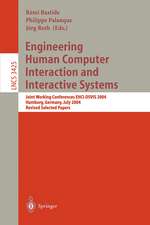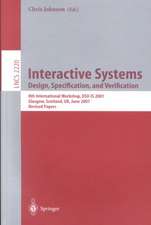Human-Computer Interaction. Theories, Methods, and Tools: 16th International Conference, HCI International 2014, Heraklion, Crete, Greece, June 22-27, 2014, Proceedings, Part I: Lecture Notes in Computer Science, cartea 8510
Editat de Masaaki Kurosuen Limba Engleză Paperback – 27 mai 2014
Din seria Lecture Notes in Computer Science
- 20%
 Preț: 1061.55 lei
Preț: 1061.55 lei - 20%
 Preț: 340.32 lei
Preț: 340.32 lei - 20%
 Preț: 341.95 lei
Preț: 341.95 lei - 20%
 Preț: 453.32 lei
Preț: 453.32 lei - 20%
 Preț: 238.01 lei
Preț: 238.01 lei - 20%
 Preț: 340.32 lei
Preț: 340.32 lei - 20%
 Preț: 438.69 lei
Preț: 438.69 lei -
 Preț: 449.57 lei
Preț: 449.57 lei - 20%
 Preț: 343.62 lei
Preț: 343.62 lei - 20%
 Preț: 148.66 lei
Preț: 148.66 lei - 20%
 Preț: 310.26 lei
Preț: 310.26 lei - 20%
 Preț: 256.27 lei
Preț: 256.27 lei - 20%
 Preț: 645.28 lei
Preț: 645.28 lei - 17%
 Preț: 427.22 lei
Preț: 427.22 lei - 20%
 Preț: 655.02 lei
Preț: 655.02 lei - 20%
 Preț: 307.71 lei
Preț: 307.71 lei - 20%
 Preț: 1075.26 lei
Preț: 1075.26 lei - 20%
 Preț: 591.51 lei
Preț: 591.51 lei -
 Preț: 381.21 lei
Preț: 381.21 lei - 20%
 Preț: 337.00 lei
Preț: 337.00 lei - 15%
 Preț: 438.59 lei
Preț: 438.59 lei - 20%
 Preț: 607.39 lei
Preț: 607.39 lei - 20%
 Preț: 538.29 lei
Preț: 538.29 lei -
 Preț: 389.48 lei
Preț: 389.48 lei - 20%
 Preț: 326.98 lei
Preț: 326.98 lei - 20%
 Preț: 1414.79 lei
Preț: 1414.79 lei - 20%
 Preț: 1024.44 lei
Preț: 1024.44 lei - 20%
 Preț: 579.30 lei
Preț: 579.30 lei - 20%
 Preț: 575.48 lei
Preț: 575.48 lei - 20%
 Preț: 583.40 lei
Preț: 583.40 lei - 20%
 Preț: 763.23 lei
Preț: 763.23 lei - 15%
 Preț: 580.46 lei
Preț: 580.46 lei - 17%
 Preț: 360.19 lei
Preț: 360.19 lei - 20%
 Preț: 504.57 lei
Preț: 504.57 lei - 20%
 Preț: 172.69 lei
Preț: 172.69 lei - 20%
 Preț: 369.12 lei
Preț: 369.12 lei - 20%
 Preț: 353.50 lei
Preț: 353.50 lei - 20%
 Preț: 585.88 lei
Preț: 585.88 lei -
 Preț: 410.88 lei
Preț: 410.88 lei - 20%
 Preț: 596.46 lei
Preț: 596.46 lei - 20%
 Preț: 763.23 lei
Preț: 763.23 lei - 20%
 Preț: 825.93 lei
Preț: 825.93 lei - 20%
 Preț: 649.49 lei
Preț: 649.49 lei - 20%
 Preț: 350.21 lei
Preț: 350.21 lei - 20%
 Preț: 309.90 lei
Preț: 309.90 lei - 20%
 Preț: 122.89 lei
Preț: 122.89 lei
Preț: 665.93 lei
Preț vechi: 832.42 lei
-20% Nou
Puncte Express: 999
Preț estimativ în valută:
127.45€ • 132.70$ • 107.71£
127.45€ • 132.70$ • 107.71£
Carte tipărită la comandă
Livrare economică 11-25 martie
Preluare comenzi: 021 569.72.76
Specificații
ISBN-13: 9783319072326
ISBN-10: 3319072323
Pagini: 712
Ilustrații: XL, 669 p. 188 illus.
Dimensiuni: 155 x 235 x 38 mm
Greutate: 0.98 kg
Ediția:2014
Editura: Springer International Publishing
Colecția Springer
Seriile Lecture Notes in Computer Science, Information Systems and Applications, incl. Internet/Web, and HCI
Locul publicării:Cham, Switzerland
ISBN-10: 3319072323
Pagini: 712
Ilustrații: XL, 669 p. 188 illus.
Dimensiuni: 155 x 235 x 38 mm
Greutate: 0.98 kg
Ediția:2014
Editura: Springer International Publishing
Colecția Springer
Seriile Lecture Notes in Computer Science, Information Systems and Applications, incl. Internet/Web, and HCI
Locul publicării:Cham, Switzerland
Public țintă
ResearchCuprins
Design Theories, Methods and Tools.-Psychological Personas for Universal User Modeling in Human-Computer Interaction.- Immediacy in User Interfaces: An Activity Theoretical Approach.- The Resilience of Analog Tools in Creative Work Practices: A Case Study of LEGO Future Lab’s Team in Billund.- Using Cultural Probes to Inform the Design of Assistive Technologies.- Is There HCI in IDTV? An Exploratory Study on Their Words.- A Knowledge-Construction Perspective on Human Computing, Collaborative Behavior and New Trends in System Interactions.- A Revised Lexical Approach for Analyzing Online Reviews.- Ergonomics in the Practice of Project Architect on Selected Examples.- Color Saliency Research on Visual Perceptual Layering Method.- Generating Human-Computer Micro-task Workflows from Domain Ontologies.- Methodological Capabilities for Emergent Design.- Value Pie: A Culturally Informed Conceptual Scheme for Understanding Values in Design.- The Formulation and Visualization of 3D Avatar Design, Including Three Basic Theoretical Elements: Aesthetic, User Experience and Psychology.- Augmentation and the Visual Mind.- Scripting Interactive Art Installations in Public Spaces.- Design-Neuroscience: Interactions between the Creative and Cognitive Processes of the Brain and Design.- HCI and Design Education.- Charting the Landscape of HCI Education in Brazil.- Human-Computer Interaction Education and Diversity.- Tangible Disparity - Different Notions of the Material as Catalyst of Interdisciplinary Communication.- Improvement of Novice Software Developers’ Understanding about Usability: The Role of Empathy Toward Users as a Case of Emotional Contagion.- Fast and Not Furious.- Teaching and Learning HCI Online.- Comparison of Creativity Enhancement and Idea Generation Methods in Engineering Design Training.- Studio-Based Learning as a Natural Fit to Teaching Human-Computer Interaction.- Teaching Design for All Through Empathic Modeling: A Case Study in Tallinn University.- Models,Patterns and Tools for UI Development.- HCI Prototyping and Modeling of Future Psychotherapy Technologies in Second Life.- Combining Design of Models for Smart Environments with Pattern-Based Extraction.- Evaluation of Model-Based User Interface Development Approaches.- Engineering Variance: Software Techniques for Scalable, Customizable, and Reusable Multimodal Processing.- HCI-Patterns for Developing Mobile Apps and Digital Video-Assist-Technology for the Film Set.- IntNovate a Toolkit to Ease the Implementation of Every Interaction Paradigm on Every Device.- One Interface, Many Views: A Case for Repeatable Patterns.- Picture-Driven User Interface Development for Applications on Multi-platforms.- PeNTa: Formal Modeling for Multi-touch Systems Using Petri Net.- An Iterative and Incremental Process for Interaction Design through Automated GUI Generation.- Adaptive and Personalized Interfaces.- A Model and Guidelines for the Interface Design Process for Adaptive Web Applications (IDPAWA).- A Model to Promote Interaction between Humans and Data Fusion Intelligence to Enhance Situational Awareness.- Visualization Adaptation Based on Environmental Influencing Factors.- Intelligent Document User Interface Design Using MVC and UIML.- Log-Based Personalization Tool as an Assistive Technology.- A Practical Solution for the Automatic Generation of User Interfaces – What Are the Benefits of a Practical Solution for the Automatic Generation of User Interfaces?.- Proposal of Collaborative Learning Support Method in Risk Communications.- Evaluation Methods, Techniques and Case Studies.- Towards Qualitative and Quantitative Data Integration Approach for Enhancing HCI Quality Evaluation.- Efficiency in Performing Basic Tasks Using Word Processing Programs by the Elderly as a Measure of the Ergonomic Quality of Software.- Guidelines for Usability Field Tests in the Dynamic Contexts of Public Transport.- Integrating Usability Evaluations into Scrum: A Case Study Based on Remote Synchronous User Testing.- Evaluating an Automatic Adaptive Delivery Method of English Words Learning Contents for University Students in Science and Technology.- Can Users Speak for Themselves? Investigating Users Ability to Identify Their Own Interactive Breakdowns.- Reflections on the Cross-Platform Semiotic Inspection Method.- Evaluating Methods and Equipment for Usability Field Tests in Public Transport.- ErgoSV: An Environment to Support Usability Evaluation Using Face and Speech Recognition.- Identifying Intention and Perception Mismatches in Digitally Augmented Museum Settings.- Heuristics for Assessing Emotional Response of Viewers during the Interaction with TV Programs.- Evaluation of Industrial Touch Interfaces Using a Modular Software Architecture.- Visualisation Methods and Techniques.- 3D Face-Aware Electronics with Low-Resolution Imaging.- Timeline Localization.- Design Criteria for Public Display User Interfaces.- Recommender System to Support Chart Constructions with Statistical Data.- Deterministic Local Layouts through High-Dimensional Layout Stitching.- SyncBox - Synchronizer and Interface for High-Speed Macro Photography.
Textul de pe ultima copertă
The 3-volume set LNCS 8510, 8511 and 8512 constitutes the refereed proceedings of the 16th International Conference on Human-Computer Interaction, HCII 2014, held in Heraklion, Crete, Greece in June 2014.
The total of 1476 papers and 220 posters presented at the HCII 2014 conferences was carefully reviewed and selected from 4766 submissions. These papers address the latest research and development efforts and highlight the human aspects of design and use of computing systems. The papers thoroughly cover the entire field of human-computer interaction, addressing major advances in knowledge and effective use of computers in a variety of application areas.
The total of 1476 papers and 220 posters presented at the HCII 2014 conferences was carefully reviewed and selected from 4766 submissions. These papers address the latest research and development efforts and highlight the human aspects of design and use of computing systems. The papers thoroughly cover the entire field of human-computer interaction, addressing major advances in knowledge and effective use of computers in a variety of application areas.





























